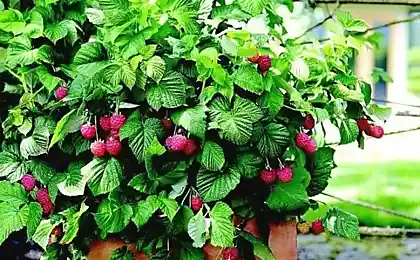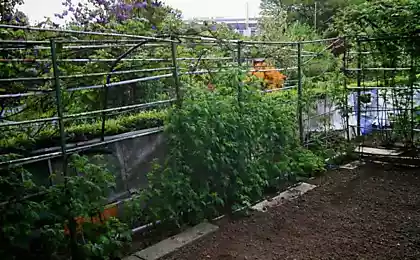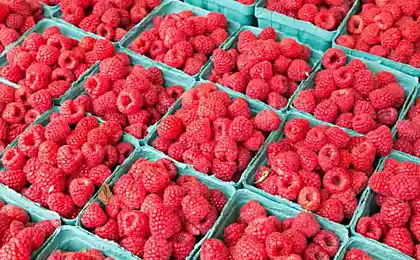707
Golden tips on how to breed and propagate raspberries remontant
Considerable popularity among gardeners remontant raspberries time purchased. This kind favorably ability to bear fruit as the first year, and two-year shoots, and even to give two crops of berries per year, which, in fact, encourages its breeding. But how to propagate raspberries remontant - is another question
. Features remontant raspberry breeding
A feature of the type is that it is peculiar to annually produce new shoots from the roots, some of which die off in the fall. The remaining shoots next year form a fruitful branches. This can be in the year of planting to harvest in August and September, and a year on two-year shoots, fruits ripen in June, annual young fruit again in the early autumn.
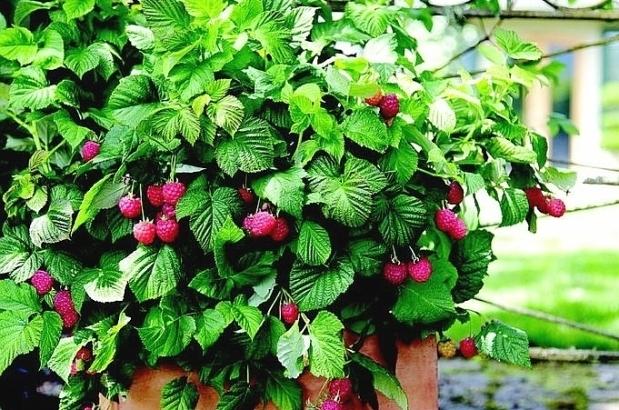
However, autumn fruits often are obtained by the size and quality worse than the summer. All because summer fruiting shoots at the biennial plant drains, thereby decelerating the maturation of the second crop. Therefore, many gardeners prefer to collect only one harvest to the young shoots.
If, after the acquisition of high-quality seedlings, you plan to further dilution remontant raspberries, it is important to put it. Place for it is better to choose the sun, and in the southern regions more suitable for partial shade. Although raspberries grow on almost any soil, the best results can be achieved on the loose and fertile soil. Before planting, they should be enriched with a mixture of humus with superphosphate and potassium fertilizer and compost.
For further breeding a raspberry is better to plant in rows, at least 1, 5 m and the space between the bushes with the distance between them - 0, 7 m
. Malina sits in the pit depth of 30 cm and a diameter of 35 cm, and the root collar should be left on the soil level. Its penetration into the ground up to 5 cm is permissible only in the loose and light soils.
On small areas it is also acceptable to plant raspberries remontant in groups of 3 plants at a distance of 0, 5-0, 7 meters.
Planted the first plants, many are thinking: how to propagate raspberries remontant .. But in terms of breeding and shows another feature of this type: a limited number of root suckers and slightly branched root system significantly complicates the process of reproduction of the usual ways
. Methods for breeding raspberries remontant
The most effective methods is considered a transplant 2-3-year-old bushes and reproduction remontant raspberry cuttings.
1. The root shoots.
In this case, in 2-3 years after planting, the central part of the bush (10-15 cm diameter) dug and transplanted. From left in the ground suckers may develop up to 20 offspring. This procedure is carried out in early spring or autumn. The main thing is to remember that the offspring of the roots tend to develop unevenly and can germinate throughout the growing season.
2. Cuttings.
Productive farming practices and breeding is remontant raspberry cuttings. Since green cuttings on these varieties of raspberries are usually small, planting material harvested several times. Green cuttings grown in the spring and early summer, are considered to be the highest quality, because this escapes gets more nutrients.
For breeding cuttings suited to the already formed leaf rosette and a height of no more than 3-5 cm, called in "Krapivko" people. The stalks are cut to a depth of 5 cm, so that it definitely was light etiolated zone - this is part of the shoot, which is under the ground, from which later appear roots
. Broken escape removed with a small amount of land. Before planting in the greenhouse section, you can update and sprinkled with charcoal. To put these cuttings in water can not be, because it gradually leaches nutrients.
Transplanted in light soil cuttings are usually two to three weeks, let your roots. Responding to a question, how to breed remontant raspberry cuttings, it is worth noting that the rooting shoots better in a greenhouse. Thus they are thrown in scheme 5 by 10 cm planting depth equal to that at which they grew to separation from the mother plant. You can put a little deeper, but no more than 1, 5 cm.
The soil for rooting is best to enrich the mixture of peat and river sand. Cuttings should be watered regularly and protect it from overheating. When they take root and begin to grow, the greenhouse is open to the seedlings quenched. Also at this stage it is important to make sure that the young shoots were not affected by pests or fungi. Already hardened and accustomed to the sun cuttings transplanted into open ground.
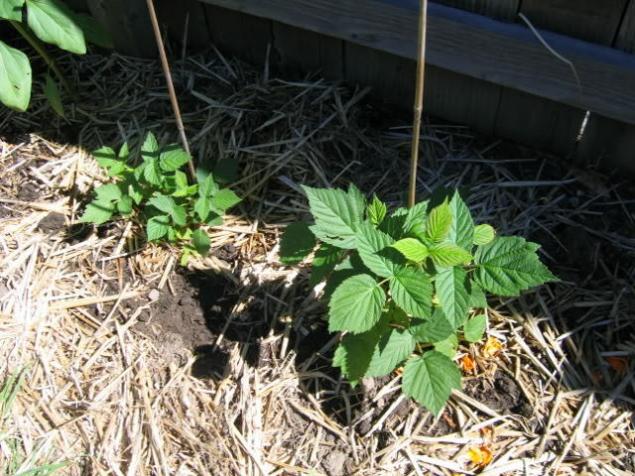
3. Other methods.
Some varieties can be particularly difficult to root. In such cases, the multiplication is performed micropropagation method. It is also possible the cultivation of raspberry seeds, about which technology mentioned earlier.
Remontant raspberries - practical and beneficial, as is able to provide both early and late crops, poorly amenable to the influence of pests and diseases, due to the fact that most of its shoots die back in the fall or mow, for the same reason it is better to tolerate the winter.
. Features remontant raspberry breeding
A feature of the type is that it is peculiar to annually produce new shoots from the roots, some of which die off in the fall. The remaining shoots next year form a fruitful branches. This can be in the year of planting to harvest in August and September, and a year on two-year shoots, fruits ripen in June, annual young fruit again in the early autumn.

However, autumn fruits often are obtained by the size and quality worse than the summer. All because summer fruiting shoots at the biennial plant drains, thereby decelerating the maturation of the second crop. Therefore, many gardeners prefer to collect only one harvest to the young shoots.
If, after the acquisition of high-quality seedlings, you plan to further dilution remontant raspberries, it is important to put it. Place for it is better to choose the sun, and in the southern regions more suitable for partial shade. Although raspberries grow on almost any soil, the best results can be achieved on the loose and fertile soil. Before planting, they should be enriched with a mixture of humus with superphosphate and potassium fertilizer and compost.
For further breeding a raspberry is better to plant in rows, at least 1, 5 m and the space between the bushes with the distance between them - 0, 7 m
. Malina sits in the pit depth of 30 cm and a diameter of 35 cm, and the root collar should be left on the soil level. Its penetration into the ground up to 5 cm is permissible only in the loose and light soils.
On small areas it is also acceptable to plant raspberries remontant in groups of 3 plants at a distance of 0, 5-0, 7 meters.
Planted the first plants, many are thinking: how to propagate raspberries remontant .. But in terms of breeding and shows another feature of this type: a limited number of root suckers and slightly branched root system significantly complicates the process of reproduction of the usual ways
. Methods for breeding raspberries remontant
The most effective methods is considered a transplant 2-3-year-old bushes and reproduction remontant raspberry cuttings.
1. The root shoots.
In this case, in 2-3 years after planting, the central part of the bush (10-15 cm diameter) dug and transplanted. From left in the ground suckers may develop up to 20 offspring. This procedure is carried out in early spring or autumn. The main thing is to remember that the offspring of the roots tend to develop unevenly and can germinate throughout the growing season.
2. Cuttings.
Productive farming practices and breeding is remontant raspberry cuttings. Since green cuttings on these varieties of raspberries are usually small, planting material harvested several times. Green cuttings grown in the spring and early summer, are considered to be the highest quality, because this escapes gets more nutrients.
For breeding cuttings suited to the already formed leaf rosette and a height of no more than 3-5 cm, called in "Krapivko" people. The stalks are cut to a depth of 5 cm, so that it definitely was light etiolated zone - this is part of the shoot, which is under the ground, from which later appear roots
. Broken escape removed with a small amount of land. Before planting in the greenhouse section, you can update and sprinkled with charcoal. To put these cuttings in water can not be, because it gradually leaches nutrients.
Transplanted in light soil cuttings are usually two to three weeks, let your roots. Responding to a question, how to breed remontant raspberry cuttings, it is worth noting that the rooting shoots better in a greenhouse. Thus they are thrown in scheme 5 by 10 cm planting depth equal to that at which they grew to separation from the mother plant. You can put a little deeper, but no more than 1, 5 cm.
The soil for rooting is best to enrich the mixture of peat and river sand. Cuttings should be watered regularly and protect it from overheating. When they take root and begin to grow, the greenhouse is open to the seedlings quenched. Also at this stage it is important to make sure that the young shoots were not affected by pests or fungi. Already hardened and accustomed to the sun cuttings transplanted into open ground.

3. Other methods.
Some varieties can be particularly difficult to root. In such cases, the multiplication is performed micropropagation method. It is also possible the cultivation of raspberry seeds, about which technology mentioned earlier.
Remontant raspberries - practical and beneficial, as is able to provide both early and late crops, poorly amenable to the influence of pests and diseases, due to the fact that most of its shoots die back in the fall or mow, for the same reason it is better to tolerate the winter.
The machine for water treatment generates electricity and distributes free Wi-Fi
This product is super fights free radicals and rejuvenates the body!



